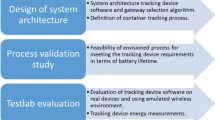Abstract
Expected to replace current logistic systems, the Physical Internet (PI) motivates to redesign its suitable logistic facilities in which the information system to manage all operations is also changed. In this context, the PI-containers and their encapsulation process (composition/decomposition) are key elements for an open global logistic infrastructure. Although the constitution of a composite container is assumed perfectly known when it was set up, the large variety of manual or automated handling, storage and routing operations in Physical Internet can introduce de synchronization between the real composition of a PI-container and the management information system. The reliance on active objects is a way to overcome this problem. Current RFID technology can serve to identify each container within radio range, but cannot pinpoint its exact location. Fine-grained RFID localization has recently received much attention but these approaches are mainly based on received signals’ parameters such as the signal strength (RSSI), time of flight (ToA/TDoA) or angle of arrival. The scope of this paper is to exploit the power of combining spontaneous networking offered by Wireless Sensor Networks with virtual representation. The proposed approach doesn’t depend on the quality of received signals that is important in harsh environment. The authors demonstrate that an instantaneous consolidated view of a composite container can be obtained and serve to synchronize both physical and informational flows providing new value-added services.
Access this chapter
Tax calculation will be finalised at checkout
Purchases are for personal use only
Similar content being viewed by others
References
Sallez, Y., Montreuil, B., Ballot, E.: On the activeness of physical internet containers. In: Borangiu, T., Trentesaux, D., Thomas, A. (eds.) Service Orientation in Holonic and Multi-agent Manufacturing. Springer series Studies in Computational Intelligence, Vol. 594, pp. 259–269 (2015)
Wong, C.Y., McFarlane, D., Zaharudin, A.A., Agarwal, V.: The intelligent product driven supply chain. In: IEEE International Conference on Systems, Man and Cybernetics, Hammamet, Tunis (2002)
Sallez, Y.: Proposition of an analysis framework to describe the “activeness” of a product during its life cycle—part I: Method and applications. In: Borangiu, T., Trentesaux, D. (eds) Service Orientation in Holonic and Multi-Agent Manufacturing Control, Studies in Computational Intelligence, vol. 544, pp. 271–282. Springer (2014)
Sallez, Y.: The augmentation concept: how to make a product “active” during its life cycle. In: Borangiu, T., Trentesaux, D. (eds) Service Orientation in Holonic and Multi-Agent Manufacturing Control, Studies in Computational Intelligence, vol. 402, pp. 35–48. Springer (2012)
Verdouw, C.N., Beulens, A.J.M., Reijers, H.A.: A control model for object virtualization in supply chain management, Computers in Industry, Vol. 68, 116–131, Apr 2015
Ballot, E., Montreuil, B., Meller, R.D.: The Physical Internet: The Network of the Logistics Networks. La Documentation Française, Paris (2014)
Montreuil, B.: Towards a physical internet: meeting the global logistics sustainability grand challenge. Logistics Res. 3(2–3), 71–87 (2011)
Montreuil, B., Ballot, E., Tremblay, W.: Modular Structural Design of Physical Internet Containers. Prog. Mater. Handling Res. 13 (2014) (MHI)
Modulushca project (2015). http://www.modulushca.eu/
Ballot, E., Montreuil, B., Thémans, M.: OPENFRET: contribution à la conceptualisation et à la réalisation d’un hub rail-route de l’Internet Physique. MEDDAT, Paris (2010)
Ballot, E., Montreuil, B., Thivierge, C.: Functional Design of Physical Internet Facilities: A Road-Rail Hub. Progress in Material Handling Research, MHIA, Charlotte, NC (2012)
Meller, R.D., Montreuil, B., Thivierge, C., Montreuil, B.: Functional Design of Physical Internet Facilities: A Road-Based Transit Center. Progress in Material Handling Research, MHIA, Charlotte, NC (2012)
Pach, C., Sallez, Y., Berger, T., Bonte, T., Trentesaux, D., Montreuil, B.: Routing management in physical internet cross docking hubs: study of grouping strategies for truck loading. In: International Conference on Advances in Production Management Systems APMS, IFIP AICT, vol. 438, pp. 483–490. Springer, Sept 2014
Bortfeldt, A., Wäscher, G.: Container loading problems—a state-of-the-art review. Otto-von-Guericke Universität Magdeburg, Working Paper No. 7/2012 (2012)
Tran-Dang, H., Krommenacker, N., Charpentier, P.: Enhancing the functionality of physical internet containers by WSN. In: International Physical Internet Conference. Paris, July 2015
Author information
Authors and Affiliations
Corresponding author
Editor information
Editors and Affiliations
Rights and permissions
Copyright information
© 2016 Springer International Publishing Switzerland
About this chapter
Cite this chapter
Krommenacker, N., Charpentier, P., Berger, T., Sallez, Y. (2016). On the Usage of Wireless Sensor Networks to Facilitate Composition/Decomposition of Physical Internet Containers. In: Borangiu, T., Trentesaux, D., Thomas, A., McFarlane, D. (eds) Service Orientation in Holonic and Multi-Agent Manufacturing. Studies in Computational Intelligence, vol 640. Springer, Cham. https://doi.org/10.1007/978-3-319-30337-6_8
Download citation
DOI: https://doi.org/10.1007/978-3-319-30337-6_8
Published:
Publisher Name: Springer, Cham
Print ISBN: 978-3-319-30335-2
Online ISBN: 978-3-319-30337-6
eBook Packages: EngineeringEngineering (R0)




